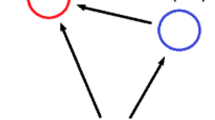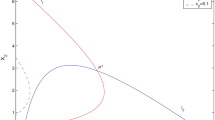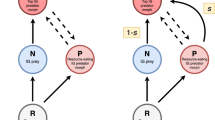Abstract
Intraguild predation (IGP) is a combination of competition and predation which is the most basic system in food webs that contains three species where two species that are involved in a predator/prey relationship are also competing for a shared resource or prey. We formulate two intraguild predation (IGP: resource, IG prey and IG predator) models: one has generalist predator while the other one has specialist predator. Both models have Holling-Type I functional response between resource-IG prey and resource-IG predator; Holling-Type III functional response between IG prey and IG predator. We provide sufficient conditions of the persistence and extinction of all possible scenarios for these two models, which give us a complete picture on their global dynamics. In addition, we show that both IGP models can have multiple interior equilibria under certain parameters range. These analytical results indicate that IGP model with generalist predator has “top down” regulation by comparing to IGP model with specialist predator. Our analysis and numerical simulations suggest that: (1) Both IGP models can have multiple attractors with complicated dynamical patterns; (2) Only IGP model with specialist predator can have both boundary attractor and interior attractor, i.e., whether the system has the extinction of one species or the coexistence of three species depending on initial conditions; (3) IGP model with generalist predator is prone to have coexistence of three species.












Similar content being viewed by others
References
Amarasekare P (2007) Spatial dynamics of communities with intraguild predation: the role of dispersal strategies. Am Nat 170:819–831
Amarasekare P (2008) Coexistence of intraguild predators and prey in resource-rich environments. Ecology 89:2786–2797
Arim M, Marquet PA (2004) Intraguild predation: a widespread interaction related to species biology. Ecol Lett 7:557–564
Brodeur J, Rosenheim JA (2000) Intraguild interactions in aphid parasitoids. Entomologia Experimentalis et Applicata 97:93–108
Diehl S (1993) Relative consumer sizes and the strengths of direct and indirect interactions in omnivorous feeding relationships. Oikos 68:151–157
Guckenheimer J, Holmes P (1983) Nonlinear oscillations, dynamical systems, and bifurcations of vector fields. Springer, Berlin
Hall R (2011) Intraguild predation in the presence of a shared natural enemy. Ecology 92:352–361
Hanski I, Hansson L, Henttonen H (1991) Specialist predators, generalist predators, and the microtine rodent cycle. J Anim Ecol 60:353–367
Hassell MP, May RM (1986) Generalist and specialist natural enemies in insect predator–prey interactions. Br Ecol Soc 55:923–940
Holling CS (1959) Some Characteristics of Simple Types of Predation and Parasitism. The Canadian Entomologist 91:385–398
Holt RD, Polis GA (1997) A theoretical framework for intraguild predation. Am Nat 149:745–764
Hutson V (1984) A theorem on average Liapunov functions. Monatshefte für Mathematik 98:267–275
Hutson V, Schimtt K (1992) Permanence and the dynamics of biological systems. Math Biosci 111:1–71
McCann K, Hastings A, Huxel GR (1998) Weak trophic interactions and the balance of nature. Nature 395:794–798
Polis GA, Holt RD (1992) Intraguild predation: the dynamics of complex trophic interactions. Trends Ecol 7:51–154
Rosenheim JA (1998) Higher-order predators and the regulation of insect herbivore populations. Ann Rev Entomol 43:421–447
Ruggieri E, Schreiber SJ (2005) The dynamics of the Schoener–Polis–Holt model of intraguild predation. Math Biosci Eng 2:279–288
Schauber EM, Ostfeld RS, Jones CG (2004) Type 3 functional response of mice to gypsy moth pupae: is it stabilizing? OIKOS 107:592–602
Sieber M, Hilker FM (2011) Prey, predators, parasites: intraguild predation or simpler community modules in disguise? J Anim Ecol 80:414–421
Sieber M, Hilker FM (2012) The hydra effect in predatorprey models. J Math Biol 64:341–360
Snyder WE, Ives AR (2003) Interactions between specialist and generalist natural enemies: parasitoids, predators, and pea aphid biocontrol. Ecol Soc Am 84:91–107
Spiller DA, Schoener TW (1990) A terrestrial field experiment showing the impact of eliminating top predators on foliage damage. Nature 347:469–472
Sunderland KD, Axelsen JA, Dromph K, Freier B, Hemptinne J-L, Holst NH, Mols PJ, Petersen MK, Powell W, Ruggle P, Triltsch H, Winder L (1997) Pest control by a community of natural enemies. Acta Jutlandica 72:271–326
Yeakel JD, Stiefs D, Novak M, Gross T (2011) Generalized modeling of ecological population dynamics. Theor Ecol 4:179–194
Acknowledgments
The research of Y.K. is partially supported by Simons Collaboration Grants for Mathematicians (208902).
Author information
Authors and Affiliations
Corresponding author
Appendix
Appendix
1.1 The persistence and extinction results in terms of the original parameters
In this Appendix, we convert the persistence and extinction results of scaled models (4), (5) to the results of their original forms (2), (3). See Tables 7, 8, 9, 10.
Rights and permissions
About this article
Cite this article
Kang, Y., Wedekin, L. Dynamics of a intraguild predation model with generalist or specialist predator. J. Math. Biol. 67, 1227–1259 (2013). https://doi.org/10.1007/s00285-012-0584-z
Received:
Revised:
Published:
Issue Date:
DOI: https://doi.org/10.1007/s00285-012-0584-z




